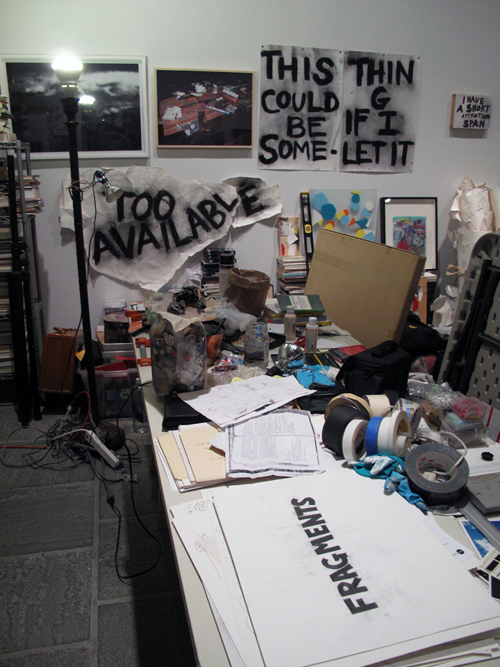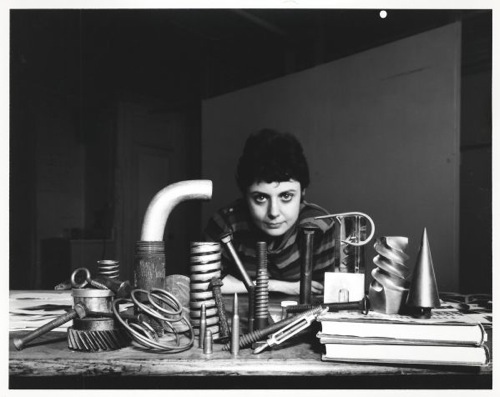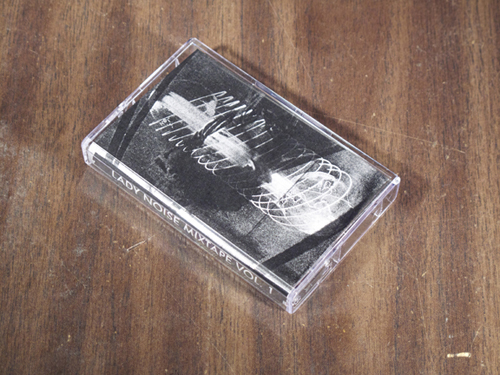
I spent an afternoon with Dawn Kasper at her installation This Could Be Something If I Let It at the Whitney Biennial. The following post is a document of that experience, and is meant to follow the collage-like form of Dawn’s work.
3:00 pm: I show up and wait. I spend time observing the piles of artwork, stacks of DVDs, CDs, VHS tapes, shelves of books and equipment, photographs on the walls, videos playing on monitors, a drum set.

"Fragments," from Dawn Kasper's "This Could Be Something If I Let It," 2012, at the Whitney Biennial. Image courtesy the artist.
Two women walk by me:
“This is just like a boy and his stuff. It’s too much, I can’t take it.”
“Oh, you think so? It is quite a lot. Do you remember who this is?”
“No, but come to think of it, this might not be all of his stuff, it might belong to someone else and he just showing it.”
“You might be right, but I get the feeling this belongs to the artist. Are you sure it’s a man? I can’t see the name anywhere.”
“I think so, or it could be a woman.”
I break the news to them that it belongs to a woman. I say “Dawn Kasper, D-A-W-N.” They laugh, shrug, walk away.
I start to panic; could she just not show up to her own show? Impossible, if she’s here, she is going to have to come up eventually. I read an article on her desk about hoarding, and the lengths a son had to go to in order to empty his parents’ house. I see the connection. It’s not about the things themselves but about her attachment to them.
3:30pm: Dawn comes in, a little frayed, spinning about the installation, fixing the video, straightening something up. I start recording.
Marissa Perel: How long have you been living in Los Angeles?
Dawn Kasper: Twelve years.
MP: So, that’s home definitely?
DK: I thought to live here [New York]. But, it’s hard here. I understand there are rewards for putting up with this place, but, I’m poor so in order to live anywhere in the world, I need to live somewhere where I know how to hustle. I’ve lived in L.A. for so long that I know where to go to get food, I know where to go to eat for free. I know that kind of stuff. I don’t know that here. I mean, it’s great here, but it’s unnecessary. Eight hundred dollars for rent? It’s unnecessary. I don’t how people live here. It seems like it could be a lot of fun, but everyone’s too busy working all the time to hang out with each other.
MP: That’s true.
DK: When I first got here I was super stoked to be here and connect with people here and they were like, “Oh my God, I am so busy! Can I meet with you in a couple months?” People have to have a ton of hustles. They have to have a ton of different things going on. Then they have to manage it and micromanage it. It is amazing! I have been here for almost four months and I have adapted. I can see how much quicker I am able to process certain things since I’ve got here.
MP: Like what?
DK: Surviving! All the walking, the weather, allergies, what kind of food to eat, what not to eat. I got food poisoning when I first got here.
MP: From a Coney Island hot dog, right?
DK: Either that or some bad fish.
3:40pm: A friend from L.A. shows up: writer Sarah Lehrer-Graiwer. She joins in on the conversation about the difference between New York and L.A. and we have a little Lesbian gossip circle that takes many turns. Kasper recounts an argument with a friend over a woman that happened in the installation, right before the Michael Clark performance. The scene became so boisterous that a security guard came to intervene, but the viewers weren’t phased. Kasper said a woman was looking through her purse and muttered, “we’ve all been there, honey, it’s nothing new.” Then we flip through Mousse magazine, where an interview between Kasper and Lehrer-Graiwer is featured. Kasper asks her about what else she is doing here, and she talks about her research on Lee Lozano and the latter’s drop out of the art world in the 1970’s.

Lee Lozano in her studio. Image via www.thebookbeat.com.
Sarah Lehrer-Graiwer: She [Lozano] dropped out of the art world in the early ’70s, but she stayed in New York. It’s this weird thing. That’s what I’m writing about—her “Drop Out.” She wasn’t participating in the sense of showing, but she was present in the art world after the “Drop Out.” I went to her grave, which is unmarked in Grand Prairie, Dallas, very depressing….
DK: How’d you find it?
SLG: There was this obituary, when she died, in the Dallas Observer, which mentioned where she was buried. I tracked it down.
DK: Did she die of cancer?
SLG: Cervical cancer.
DK: Fuck, no!
SLG: It’s rough. She died in ’99. I did my Master’s thesis on her. I made an exhibition and a book that went with it a couple years ago in L.A. with Lozano, Dan Graham and Stephen Kaltenbach, whom she was close with. They had work that overlapped. Now I’m working on a book-length project on her. You guys should get back to talking! I’ll come back tomorrow.
4:00pm: We get back to the interview.
DK: I am looking forward to completely changing the space. I change it often but I left it open in the middle because the students are coming today. I am doing a workshop.
MP: What are you going to do?
DK: We are going to talk about collage. I’m going to talk about my piece and we’re going to work together to make these color-specific sculptures with objects found in the space.
MP: Cool!
DK: I think it will be fun.
MP: So, is this all of your stuff?
DK: Yes, this is everything.
MP: When you’re in L.A. do you have a studio?
DK: No, I work from home. I work from home and sometimes, and I work at my friend’s house. My friend Eric will let me use his living room to have studio visits. I met with [Biennial curators] Jay [Sanders] and Elizabeth [Sussman] there. I rearranged it and a lot of the flatwork [2D framed work] in the space was actually stored at Eric’s house. It’s the first time this work has been together like this.
MP: It seems like sometimes you capture private events, and sometimes you capture the aftermath of a performance, or something that was public. I want to know about these things, like the mattress we’re sitting on, and the band-aids and exacto blade that are framed above us.

Gina Pane. "Action Sentimentale," 1974. Image via https://www.italystar.it/.
DK: In the early 2000s when I was in school, I experimented with body modification in performance. I was interested in body art. I was inspired by Marina Abramovic, Gina Pane and Catherine Opie. In the framed piece, I branded the word “love” into my arm, and I cut a heart into my chest. I did each piece twice. I also did a tattoo piece that’s over in the corner on the other side of the room.
MP: I made a piece in art school where I carved the word “Hero” into my arm with that exact type of blade. I was trying to be the antihero of male performance artists who are very macho about their bodies. I was trying to create a dialogue with artists like Andre Stitt and Vito Acconci.
DK: Oh yeah, I was into Vito Acconci, too!
MP: Yeah?
4:20 pm: Wendy Yao, another L.A. friend, shows up. A tour comes through at the same time, where a viewer named Harvey greets us with, “Hello Ladies!” Dawn fills Wendy in on her life…at the same time Wendy and Dawn are talking, a woman comes in with a tour. There is a cacophony of voices that seems symbolic of the piece: a presentation about a performance that is a conversation where a conversation is happening. Harvey comes back to talk to Dawn, then Wendy and I talk. She tells me about Dawn’s gallery, Human Resources in L.A., and about her own shop Ooga Booga. Then they catch up about The Red Krayola, which performed at the Whitney in April, and Sandy Yang, who borrowed Dawn’s drums for the show. Wendy starts to talk about bands, and it turns out she is a virtual encyclopedia of the Riot Grrl scene. For the next 20 minutes, she gives us an imaginary tour of the 1990’s L.A. Riot Grrl, describing venues like Jabberjaw, Madame Wong’s, and Hong Kong Café, and reminiscing about Bikini Kill, Raquel Gutierrez, Jen Smith and others.

Lady Noise, MIXTAPE Vol.1. Image courtesy Dawn Kasper.
5:00 pm: Aaron Cometbus comes by and Wendy chats him up about Riot Grrls in the days of yore. Wendy leaves and Aaron stays to talk to Dawn. She starts moving things around again….
AC: You remodel?
DK: I do. That’s part of the work. It’s a sculptural installation and it’s in flux and it’s supposed to mirror my moods or mirror my intentions for that day.
AC: You don’t ever put a curtain up and hide or anything like that?
DK: You know, once I kind of hid under the covers. I had some sheets [laughter] for a little bit. But I couldn’t help it. It was too funny, because tours would come through and talk about me like I wasn’t there. So we’ve definitely developed a relationship where they’ll come and address me like, “Are you okay if we talk about you? Do you want to answer questions?” I know I’m a little moody sometimes, but we all are, right? So they are more conscientious. Whereas before, they would just kind of turn it over to me and let me describe what’s happening, but then it just got a little redundant. That’s a lot of work.
MP: And you’re not really here for a tour. You’re here to be here.
DK: That became pretty present pretty quick. It was interesting. There were a lot of things that happened in the first few weeks that became apparent. Like the tours, and certain questions, and how to answer certain questions that kept coming up. Once I even closed it off, and there were times when I’d push everything to the front, to kind of barricade the space. There was a day when I spent the whole morning blocking it off, and it didn’t work. People came in anyway. I mean, it worked and it didn’t. It was an interesting exercise because in doing that I was trying not to talk to people, but it would spark conversation and questions and people would make an effort to come and penetrate my half-assed barricade and talk to me specifically, and ask “What is this?” and “What are you working on?” and the more I talked to people the more I felt better.
Very similar to what happened with Sarah coming in, and you coming and my friend Dia coming before that, it’s like each friend that comes helps me to recognize that a lot of what is happening here is about being able to relate to people. It’s interesting because it’s changing my performance perspective. My performances have changed, even prior to coming here—I think this is the result of wanting to relate to people more and more. I don’t want to distance myself. I’m so used to having an intense performance, like one hour of intensity, and then I’m tired and I go home and I don’t even really talk to anybody. I connect, but in a specific way, a take-it-or-leave-it kind of thing.
*Part 2 of this conversation between Marissa Perel and Dawn Kasper will appear on the Art21 Blog this coming Monday, May 21.




Pingback: Gimme Shelter | Anti-Establishment in the Establishment: Dawn Kasper at the Whitney Biennial, Part 2 | Art21 Blog
Pingback: Leap of Fate ‹ bmoreart | Baltimore's Contemporary Art Authority